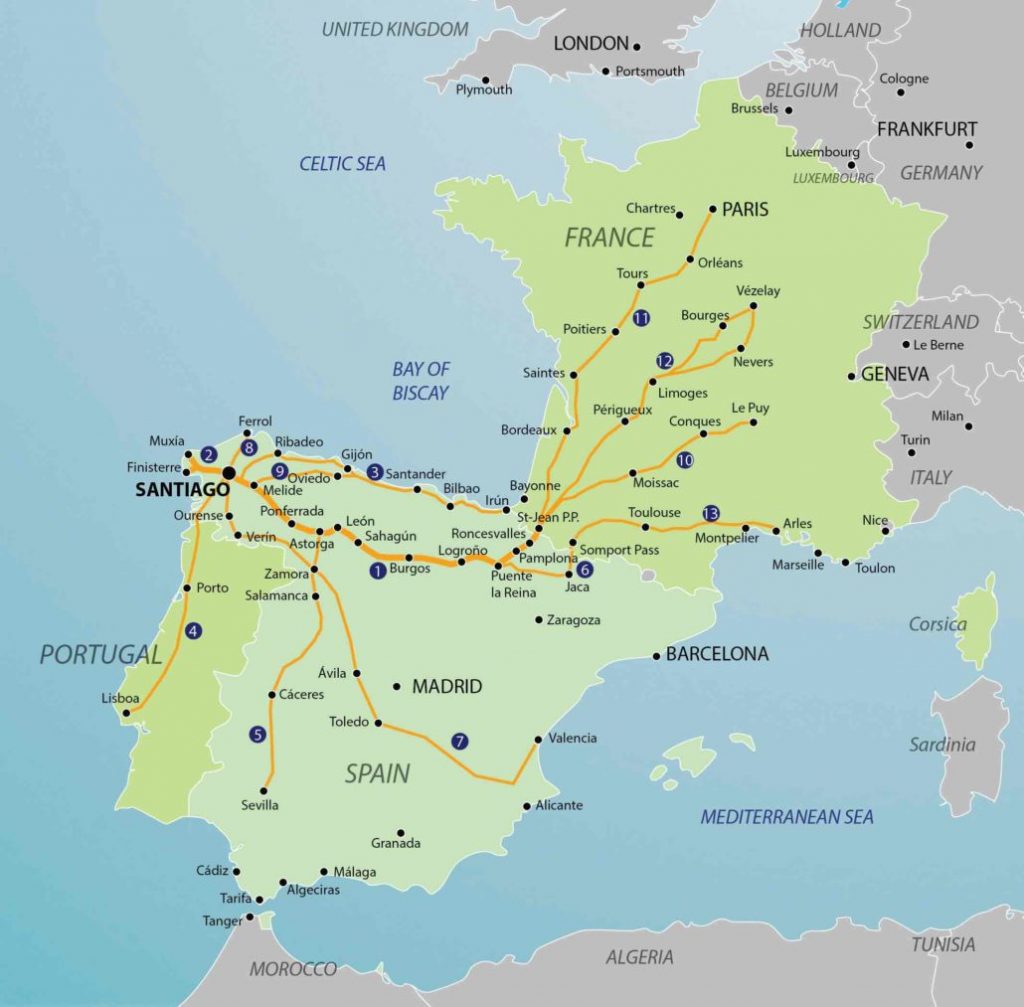There are a variety of routes and path options available to the Camino Cyclist. Here are the information to consider to get you started:
Which Camino do I ride?
Most hikers and bikers choose the Camino Francés, which is the classic route with the most services and a deep history of pilgrimage along the way. Other routes are becoming increasingly more popular as the Francés becomes crowded, such as the Camino del Norte, the Camino Portuguese, and the Via de la Plata. As a cyclist can cover significantly more distance than a walker each day, the more infrequent services on alternate routes become less of an issue. Many people incorporate a Camino bike trip into a longer European cycling tour, starting from their European home or another location in Europe and connecting to the Camino.
On the Camino Francés, what should I know about alternate routes, surface types, roads and trails?
The Camino Francés has multiple alternative routes on for some days stages for walkers and bikers, and even some pilgrims on foot choose to take the road occasionally rather than the traditional trail. There is no single “Camino,” but rather a network of routes that direct you to Santiago de Compostela. It important to be aware of the options available to determine what best matches your riding style and experience.
All paths are shared use for walkers, cyclists, horses, etc… Tension does arise at times when cyclists do not properly warn walking pilgrims when passing, so it is important to alert others along the way. It is possible for mountain bikes or capable gravel bikes to ride the full walking route with its various sections of rougher/steeper trails, but it may be required to dismount and walk the bike at times if way is crowded or a staircase suddenly appears. At times there are signs suggesting bike-specific detours and routes.
Approximately 40% of the primary route of the Camino Francés follows a paved surface, so even if you’d like to stay off asphalt, you’ll be on the road frequently as you pass through villages, towns and cities. Some larger cities have paved greenway access for cyclists (Pamplona…), which is a nice alternative for bikes, but a high impact surface for walkers who may have a dirt option.
The road always presents another alternate route for cyclists. Many riders are comfortable sharing roads with cars along the route, and may prefer to do so in order to ride on a smoother/faster surface, avoid dodging pilgrims walking the trails, and get off the beaten path to visit points of interest that are beyond a walking pilgrim’s reach. Stay safe when on the road, and be sure to follow Spanish cycling laws.
Camino Cycling Routes in Spain
These primary Camino routes in Spain begin in various locations and connect to Santiago.
- Camino Francés (800km) – view various itineraries here
- Camino Finistere (90km) – Santiago to Finisterre
- Camino Inglés (110km) – Ferrol to Santiago
- Camino Portugues (610km) – Lisboa to Santiago
- Camino del Norte (825km) – Irún to Santiago
- Via de la Plata (1000km) – Sevilla to Santiago
- Camino de Levante (1300km) – Valencia to Santiago
Camino Cycling Routes in France
These routes in France connect to the Camino Francés in St. Jean Pied-de-Port:
- Chemin de Le Puy (730km) – Le Puy to St. Jean
- Chemin de Paris (1000km) – Paris to St. Jean
- Chemin de Vézelay (900km) – Vézelay to St. Jean
- Chemin d’Arles (740km) – Arles to Samport pass
Other European Cycling Routes
- Start by checking out EuroVelo
- Via Francigena (1800km) – Canterbury to Rome
*If you live in Europe, start from your house!






